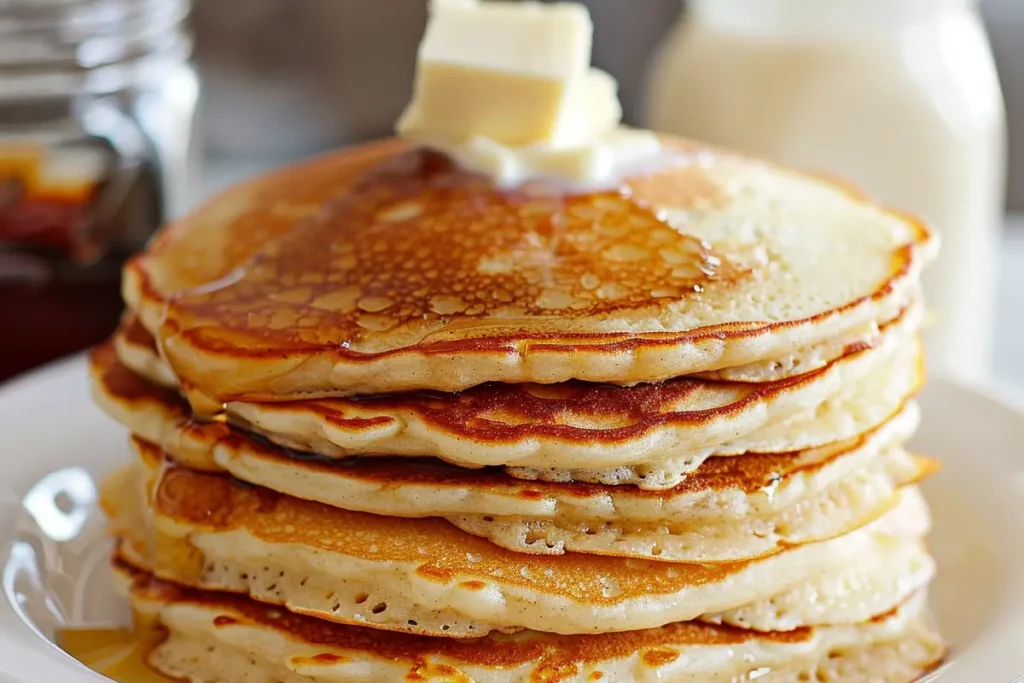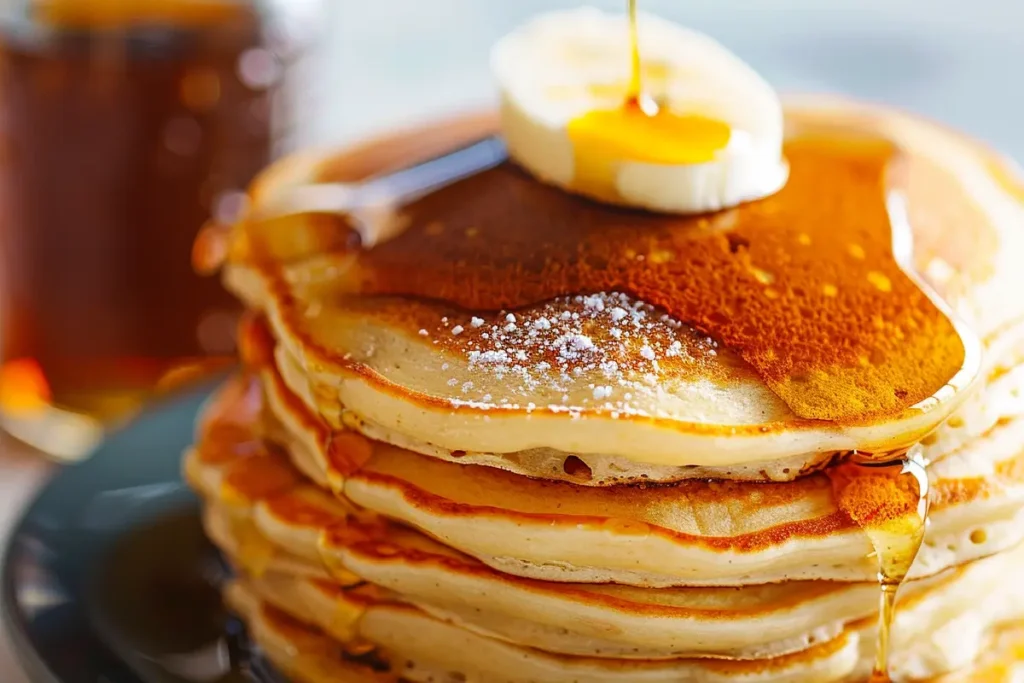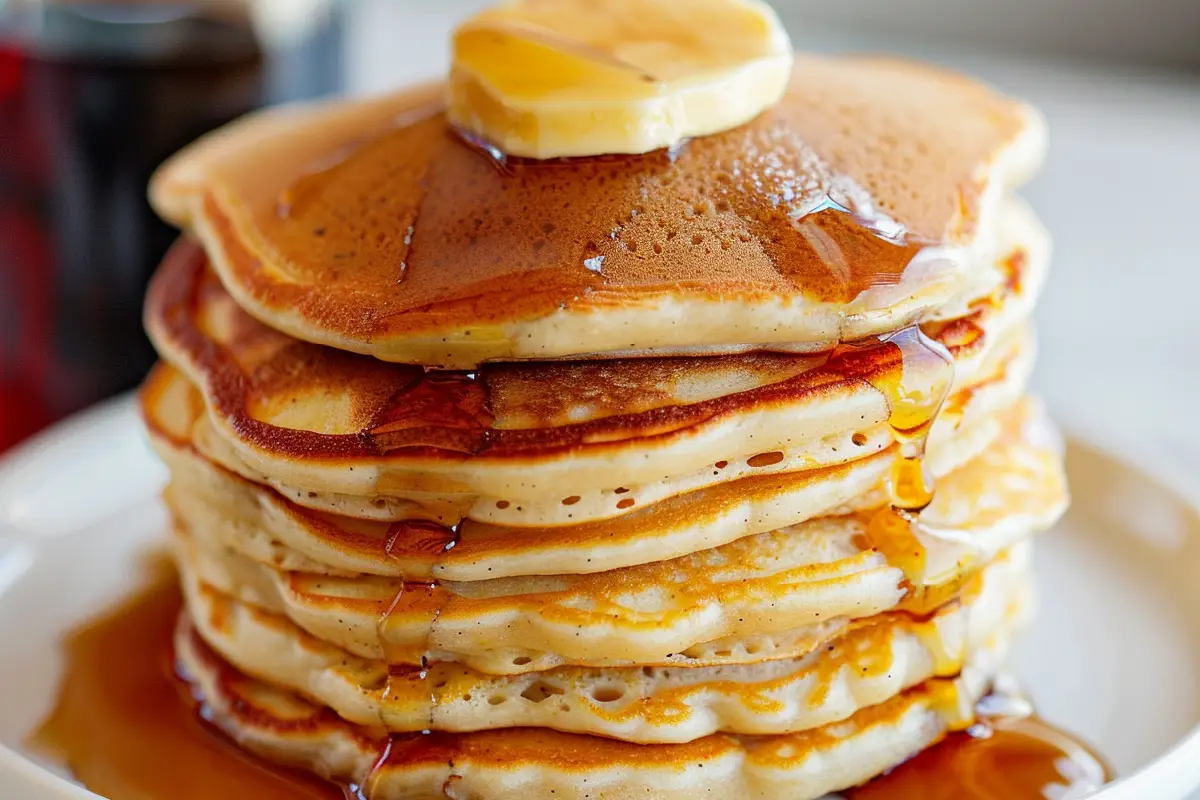Table of Contents: Is Almond Milk a Good Substitute for Pancakes?
Introduction: Is Almond Milk a Good Substitute for Pancakes?
Who doesn’t love waking up to a stack of warm, fluffy pancakes? But what if you’re out of regular milk or prefer a dairy-free option? Is almond milk a good substitute for pancakes? Absolutely! Almond milk not only keeps your pancakes light and tender but also adds a subtle nutty sweetness that takes them to the next level.
Pancakes are a breakfast classic—quick, easy, and loved by the whole family. But here’s a fun fact: Did you know that the earliest pancakes date back to ancient Greece, where they were made with wheat flour, olive oil, and honey? Today, we’ve got endless variations, and swapping dairy milk for almond milk is one of the simplest (and tastiest) tweaks you can make.
If you enjoyed our guide on Best Buttermilk Pancakes, you’ll love this dairy-free twist. Whether you’re lactose-intolerant, vegan, or just experimenting, these almond milk pancakes are just as delicious—maybe even better! Ready to flip the best stack yet? Let’s get cooking!
What Are Almond Milk Pancakes?
Ever wondered if you can make pancakes without milk? Well, almond milk pancakes are here to prove that yes, you absolutely can—and they’re amazing! The name says it all: instead of regular milk, we use almond milk for a lighter, slightly nutty, and totally irresistible breakfast.
Why almond milk? Because it’s creamy, plant-based, and works like a charm in batter. Some say, “The way to a man’s heart is through his stomach,” but honestly, the way to everyone’s heart is through a plate of golden, syrup-drizzled pancakes. Whether you’re vegan, lactose-intolerant, or just out of milk, this recipe is a game-changer. So, grab your whisk and let’s make the fluffiest almond milk pancakes ever!
Why You’ll Love This Recipe
1. Fluffy, Dairy-Free Goodness
No milk? No problem! Almond milk keeps pancakes tender and light while adding a delicate nutty flavor. They’re just as fluffy as traditional pancakes—maybe even better!
2. Budget-Friendly & Easy
Skip the expensive brunch spot. Homemade almond milk pancakes cost pennies per serving and take just 20 minutes. Plus, you control the ingredients—no weird additives!
3. Endless Topping Possibilities
Drizzle with maple syrup, pile on fresh berries, or add a dollop of almond butter. These pancakes are a blank canvas for your favorite flavors.
Love pancakes? Try our Fluffy Vegan Pancakes next! Ready to whip up a batch? Let’s go!
How to Make Almond Milk Pancakes

Quick Overview
- Prep Time: 5 mins
- Cook Time: 15 mins
- Total Time: 20 mins
- Servings: 8-10 pancakes
- Difficulty: Easy
These pancakes are quick, foolproof, and customizable—perfect for busy mornings or lazy weekends!
Key Ingredients
- 1 ½ cups all-purpose flour
- 2 tbsp sugar
- 1 tbsp baking powder
- ½ tsp salt
- 1 ¼ cups unsweetened almond milk
- 1 egg (or flax egg for vegan)
- 2 tbsp melted butter (or coconut oil)
- 1 tsp vanilla extract
Step-by-Step Instructions
- Mix Dry Ingredients
In a bowl, whisk flour, sugar, baking powder, and salt. - Combine Wet Ingredients
In another bowl, mix almond milk, egg, melted butter, and vanilla. - Make the Batter
Pour wet ingredients into dry ingredients and stir until just combined (small lumps are okay!). - Cook to Perfection
Heat a greased skillet over medium heat. Pour ¼ cup batter per pancake. Cook until bubbles form (2-3 mins), then flip and cook another 1-2 mins. - Serve & Enjoy!
Stack ‘em high and top with your favorites!
What to Serve With Almond Milk Pancakes
- Classic: Maple syrup + butter
- Fruity: Fresh berries + whipped cream
- Crunchy: Toasted almonds + honey
- Indulgent: Chocolate chips + peanut butter
Pair with: A hot cup of coffee or a refreshing almond milk latte!
Top Tips for Perfect Pancakes
✔ Don’t overmix—lumpy batter = fluffier pancakes.
✔ Let the batter rest for 5 mins for extra rise.
✔ Use medium heat to avoid burnt outsides/raw insides.
✔ Need vegan? Swap egg for 1 tbsp flaxseed + 3 tbsp water.
Storing & Reheating Tips
- Fridge: Store in an airtight container for up to 3 days.
- Freezer: Layer pancakes between parchment paper and freeze for up to 2 months.
- Reheat: Microwave for 30 secs or toast for crispiness.
FAQs: Is Almond Milk a Good Substitute for Pancakes?
1. Does almond milk make pancakes taste different?
Almond milk adds a slightly nutty, subtly sweet flavor that enhances pancakes without overpowering them. If you use unsweetened almond milk, the difference is minimal—just a lighter, fresher taste!
2. Can I use sweetened almond milk?
Yes, but reduce the sugar in the recipe slightly since sweetened almond milk adds extra sweetness. For best results, unsweetened is ideal.
3. Why are my almond milk pancakes flat?
Flat pancakes usually mean:
- Overmixed batter (stop stirring once combined!)
- Old baking powder (check the expiry date)
- Skillet not hot enough (let it preheat properly)
4. Can I make these pancakes vegan?
Absolutely! Swap the egg for a flax egg (1 tbsp flaxseed + 3 tbsp water) and use coconut oil instead of butter.
5. Does almond milk change the texture?
Nope! Almond milk keeps pancakes light and fluffy, just like dairy milk. Some brands are slightly thinner, so if your batter seems too runny, add 1-2 extra tbsp of flour.
Conclusion: Is Almond Milk a Good Substitute for Pancakes?

So, is almond milk a good substitute for pancakes? The answer is a resounding YES! Not only does it work perfectly, but it also adds a delicious twist to classic pancakes. Whether you’re dairy-free, vegan, or just experimenting, this recipe proves that you don’t need cow’s milk to make fluffy, golden, mouthwatering pancakes.
With our 5 tasty tips, you’ll get perfect results every time—no more guessing or pancake fails. Plus, almond milk pancakes are budget-friendly, easy to customize, and a great way to switch up your breakfast routine.
Print
Pancakes With Almond Milk
- Total Time: 20 minutes
- Yield: 8–10 pancakes 1x
- Diet: Vegetarian
Description
Fluffy, dairy-free pancakes made with almond milk—just as delicious as traditional pancakes but lighter and perfect for vegans or anyone avoiding dairy! Ready in 20 minutes.
Ingredients
- 1 ½ cups all-purpose flour
- 2 tbsp sugar
- 1 tbsp baking powder
- ½ tsp salt
- 1 ¼ cups unsweetened almond milk
- 1 large egg (or flax egg for vegan)
- 2 tbsp melted butter (or coconut oil)
- 1 tsp vanilla extract
Instructions
- Mix dry ingredients – In a bowl, whisk flour, sugar, baking powder, and salt.
- Combine wet ingredients – In another bowl, mix almond milk, egg, melted butter, and vanilla.
- Make batter – Pour wet ingredients into dry ingredients and stir until just combined (small lumps are okay).
- Cook pancakes – Heat a greased skillet over medium heat. Pour ¼ cup batter per pancake. Cook until bubbles form (2-3 mins), flip, and cook another 1-2 mins.
- Serve warm – Top with maple syrup, fresh fruit, or nuts.
Notes
- For vegan pancakes, use a flax egg (1 tbsp flaxseed + 3 tbsp water) and coconut oil.
- Don’t overmix – Lumpy batter = fluffier pancakes!
- Adjust thickness – If batter is too thin, add 1-2 tbsp extra flour.
- Prep Time: 5 minutes
- Cook Time: 15 minutes
- Category: Breakfast
- Method: Stovetop
- Cuisine: American
Nutrition
- Serving Size: 1 pancake
- Calories: ~120 kcal
- Sugar: 3g
- Sodium: 220mg
- Fat: 4g
- Saturated Fat: 2g
- Unsaturated Fat: 1.5g
- Trans Fat: 0g
- Carbohydrates: 18g
- Fiber: 1g
- Protein: 3g
- Cholesterol: 25mg (0mg if vegan)
Keywords: almond milk pancakes, dairy-free pancakes, fluffy pancakes, easy breakfast, vegan pancakes

